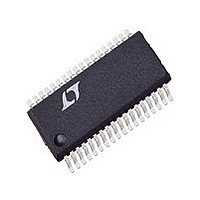LTC3731HGTR Linear Technology, LTC3731HGTR Datasheet - Page 23

LTC3731HGTR
Manufacturer Part Number
LTC3731HGTR
Description
Manufacturer
Linear Technology
Datasheet
1.LTC3731HGTR.pdf
(32 pages)
Specifications of LTC3731HGTR
Lead Free Status / RoHS Status
Not Compliant
APPLICATIO S I FOR ATIO
The power dissipation on the topside MOSFET can be
estimated. Using a Fairchild FDS6688 for example, R
= 7mΩ, C
voltage with T(estimated) = 50°C:
The worst-case power dissipation by the synchronous
MOSFET under normal operating conditions at elevated
ambient temperature and estimated 50°C junction tem-
perature rise is:
A short circuit to ground will result in a folded back current
of:
with a typical value of R
0.25. The resulting power dissipated in the bottom MOS-
FET is:
which is less than one third of the normal, full load
conditions. Incidentally, since the load no longer dissi-
pates any power, total system power is decreased by over
90%. Therefore, the system actually cools significantly
during a shorted condition!
PC Board Layout Checklist
When laying out the printed circuit board, the following
checklist should be used to ensure proper operation of the
IC. These items are also illustrated graphically in the layout
diagram of Figure 11. Check the following in the PC layout:
P
P
P
I
SYNC
SC
MAIN
SYNC
≈
=
(
MILLER
= (7.5A)
≈
2 3
0 007
⎛
⎜
⎝
20
25
1 8
+
20
.
5
.
V
mV
V
V
20
)
V
m
−
= 15nC/15V = 1000pF. At maximum input
– .
( )
Ω
1
V
2
1 3
15 1
Ω
1 8
(1.25)(0.007Ω) ≈ 0.5W
U
.
+
+
V
2
V
( )
20
[
2
DS(ON)
(
1
+
15
⎛
⎜
⎝
+
U
1 8
2
150
A
(
.
⎛
⎜
⎝
0 005 50
1
) (
( )( )
.
2
0 6
V
45
2 3
and d = (0.005/°C)(50°C) =
ns
.
⎞
⎟
⎠
1 25 0 007
(
µ
A
.
(
400
20
)
H
W
(
⎞
⎟ Ω
⎠
)
V
( )(
(
2
kHz
)
° −
⎞
⎟ =
⎠
.
C
)
1000
7 5
=
25
Ω
.
2 2
)
°
A
U
.
C
=
pF
)
W
]
1 84
DS(ON)
)
.
W
1) Are the signal and power ground paths isolated? Keep the
SGND at one end of a printed circuit path thus preventing
MOSFET currents from traveling under the IC. The IC signal
ground pin should be used to hook up all control circuitry
on one side of the IC, routing the copper through SGND,
under the IC covering the “shadow” of the package, connect-
ing to the PGND pin and then continuing on to the (–) plates
of C
placed immediately adjacent to the IC between the V
and PGND. A 1µF ceramic capacitor of the X7R or X5R type
is small enough to fit very close to the IC to minimize the ill
effects of the large current pulses drawn to drive the bottom
MOSFETs. An additional 5µF to 10µF of ceramic, tantalum
or other very low ESR capacitance is recommended in or-
der to keep the internal IC supply quiet. The power ground
returns to the sources of the bottom N-channel MOSFETs,
anodes of the Schottky diodes and (–) plates of C
should have as short lead lengths as possible.
2) Does the V
resistors? The resistive divider R1/R2 must be con-
nected between the (+) plate of C
3) Are the SENSE
each channel routed together with minimum PC trace
spacing? The filter capacitors between SENSE
for each channel should be as close as possible to the pins
of the IC. Connect the SENSE
pads of the sense resistor as illustrated in Figure 12.
4) Do the (+) plates of C
topside MOSFETs as closely as possible? This capacitor
provides the pulsed current to the MOSFETs.
5) Keep the switching nodes, SWITCH, BOOST and TG
away from sensitive small-signal nodes (SENSE
SENSE
printed circuit traces should be routed away and separated
from the IC and especially the “quiet” side of the IC.
Separate the high dv/dt traces from sensitive small-signal
nodes with ground traces or ground planes.
6) Use a low impedance source such as a logic gate to drive
the PLLIN pin and keep the lead as short as possible.
IN
and C
–
, EAIN). Ideally the SWITCH, BOOST and TG
OUT
FB
. The V
–
pin connect directly to the feedback
and SENSE
CC
PWR
decoupling capacitor should be
connect to the drains of the
–
+
printed circuit traces for
and SENSE
OUT
and signal ground.
LTC3731H
+
+
and SENSE
pins to the
IN
23
, which
CC
3731hfa
pin
+
–
,












